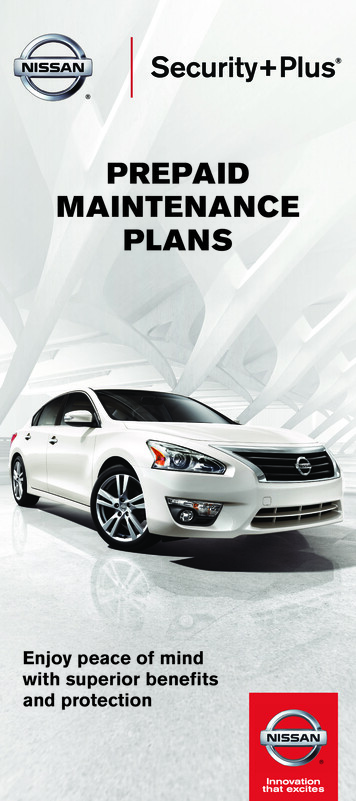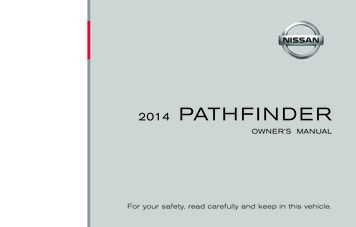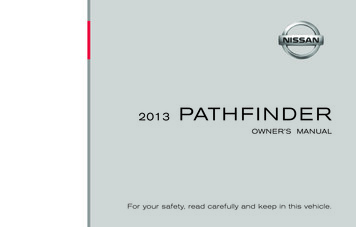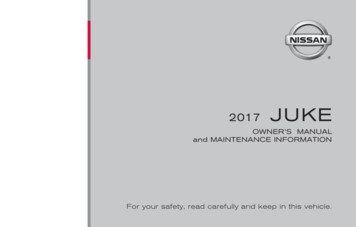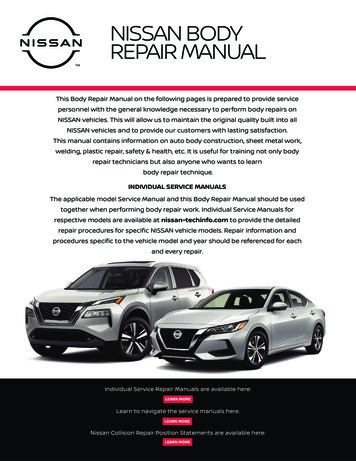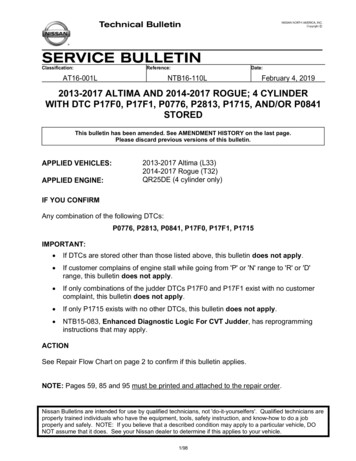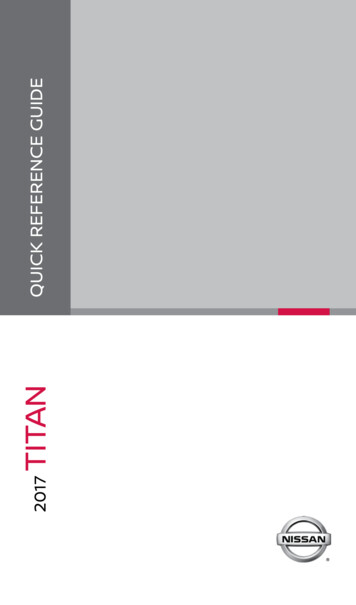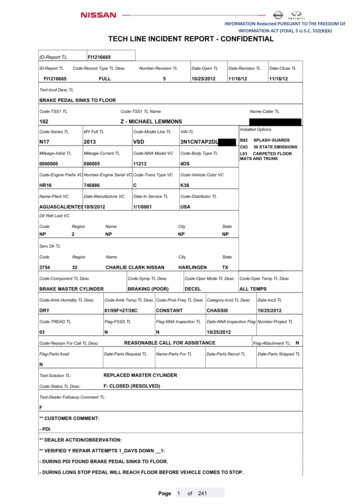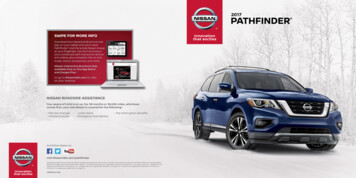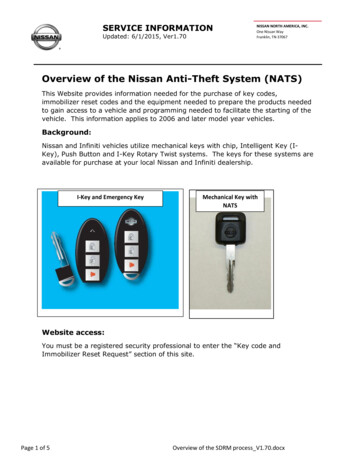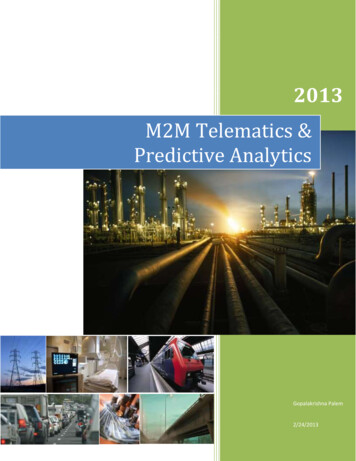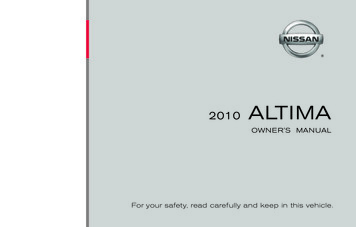
Transcription
2010ALTIMAOWNER'S MANUALFor your safety, read carefully and keep in this vehicle.
FOREWORDREAD FIRST—THEN DRIVE SAFELYWelcome to the growing family of new NISSANowners. This vehicle is delivered to you withconfidence. It was produced using the latesttechniques and strict quality control.Before driving your vehicle, please read thisOwner’s Manual carefully. This will ensure familiarity with controls and maintenance requirements, assisting you in the safe operation of yourvehicle.This manual was prepared to help you understand the operation and maintenance of yourvehicle so that you may enjoy many miles (kilometers) of driving pleasure. Please read through thismanual before operating your vehicle.WARNINGIMPORTANT SAFETY INFORMATION REMINDERS FOR SAFETY!A separate Warranty Information Bookletexplains details about the warranties covering your vehicle. The “NISSAN Serviceand Maintenance Guide” explains detailsabout maintaining and servicing your vehicle. Additionally, a separate CustomerCare/Lemon Law Booklet (U.S. only) willexplain how to resolve any concerns youmay have with your vehicle, as well asclarify your rights under your state’s lemonlaw.Follow these important driving rules tohelp ensure a safe and comfortable tripfor you and your passengers!Your NISSAN dealership knows your vehiclebest. When you require any service or have anyquestions, they will be glad to assist you with theextensive resources available to them. ALWAYS use your seat belts and appropriate child restraint systems. Preteenchildren should be seated in the rear seat. NEVER drive under the influence of alcohol or drugs. ALWAYS observe posted speed limitsand never drive too fast for conditions. ALWAYS give your full attention to drivingand avoid using vehicle features or takingother actions that could distract you. ALWAYS provide information about theproper use of vehicle safety features toall occupants of the vehicle. ALWAYS review this Owner’s Manualfor important safety information.MODIFICATION OF YOUR VEHICLEThis vehicle should not be modified.Modificationcouldaffectitsperformance, safety or durability, andmayevenviolategovernmentalregulations. In addition, damage or performance problems resulting from modifications may not be covered underNISSAN warranties.
WHEN READING THE MANUALThis manual includes information for all optionsavailable on this model. Therefore, you may findsome information that does not apply to yourvehicle.CALIFORNIA PROPOSITION 65WARNINGWARNINGAll information, specifications and illustrations inthis manual are those in effect at the time ofprinting. NISSAN reserves the right to changespecifications or design without notice and without obligation.IMPORTANT INFORMATION ABOUTTHIS MANUALYou will see various symbols in this manual. Theyare used in the following ways:WARNINGThis is used to indicate the presence of ahazard that could cause death or seriouspersonal injury. To avoid or reduce therisk, the procedures must be followedprecisely.APD1005If you see this symbol, it means “Do not do this”or “Do not let this happen.”CALIFORNIA PERCHLORATEADVISORYIf you see a symbol similar to these in an illustration, it means the arrow points to the front of thevehicle.Some vehicle parts, such as lithium batteries, may contain perchlorate material. Thefollowing advisory is provided: “PerchlorateMaterial – special handling may apply, AUTIONThis is used to indicate the presence of ahazard that could cause minor or moderate personal injury or damage to your vehicle. To avoid or reduce the risk, the procedures must be followed carefully.Engine exhaust, some of its constituents,and certain vehicle components containor emit chemicals known to the State ofCalifornia to cause cancer and birth defects or other reproductive harm. In addition, certain fluids contained in vehiclesand certain products of component wearcontain or emit chemicals known to theState of California to cause cancer andbirth defects or other reproductive harm.Arrows in an illustration that are similar to theseindicate movement or action.Arrows in an illustration that are similar to thesecall attention to an item in the illustration.
BLUETOOTH威 is atrademark owned byBluetooth SIG, Inc.,U.S.A. and licensedto Visteon andClarion.XM Radio威 requiressubscription, soldseparately after first90 days. Not availablein Alaska, Hawaii orGuam. For moreinformation, visitwww.xmradio.com. 2009 NISSAN NORTH AMERICA, INC.All rights reserved. No part of this Owner’sManual may be reproduced or stored in a retrievalsystem, or transmitted in any form, or by anymeans, electronic, mechanical, photocopying,recording or otherwise, without the prior writtenpermission of Nissan North America, Inc.
NISSAN CUSTOMER CARE PROGRAMNISSAN CARES . . .Both NISSAN and your NISSAN dealer are dedicated to serving all your automotive needs. Your satisfaction with your vehicle and your NISSAN dealer areour primary concerns. Your NISSAN dealer is always available to assist you with all your automobile sales and service needs.However, if there is something that your NISSANdealer cannot assist you with or you would like toprovide NISSAN directly with comments orquestions, please contact the NISSAN Consumer Affairs Department using our toll-freenumber:For U.S. customers1-800-NISSAN-1(1-800-647-7261)For Canadian customers1-800-387-0122The Consumer Affairs Department will ask for thefollowing information:– Your name, address, and telephone number– Vehicle identification number (attached to thetop of the instrument panel on the driver’sside)– Date of purchase– Current odometer reading– Your NISSAN dealer’s nameYou can write to NISSAN with the information at:For U.S. customersNissan North America, Inc.Consumer Affairs DepartmentP.O. Box 685003Franklin, TN 37068-5003For Canadian customersNissan Canada Inc.5290 Orbitor DriveMississauga, Ontario L4W 4Z5– Your comments or questionsORWe appreciate your interest in NISSAN and thank you for buying a quality NISSAN vehicle.
Table ofContentsIllustrated table of contents0Safety—Seats, seat belts and supplemental restraint system1Instruments and controls2Pre-driving checks and adjustments3Monitor, climate, audio, phone and voice recognition systems4Starting and driving5In case of emergency6Appearance and care7Maintenance and do-it-yourself8Technical and consumer information9Index10
0 Illustrated table of contentsAir bags, seat belts and child restraints . . . . . . . . . . . . . . 0-2Exterior front . . . . . . . . . . . . . . . . . . . . . . . . . . . . . . . . . . . . . . 0-3Exterior rear. . . . . . . . . . . . . . . . . . . . . . . . . . . . . . . . . . . . . . . 0-5Passenger compartment . . . . . . . . . . . . . . . . . . . . . . . . . . . 0-7Instrument panel. . . . . . . . . . . . . . . . . . . . . . . . . . . . . . . . . . . 0-8Engine compartment check locations . . . . . . . . . . . . . . . 0-10Warning/indicator lights . . . . . . . . . . . . . . . . . . . . . . . . . . . 0-12
AIR BAGS, SEAT BELTS AND CHILDRESTRAINTS1.2.3.Top tether strap anchor (P. 1-28)Rear seat belts (P. 1-15)Roof-mounted curtain side-impactsupplemental air bag (P. 1-42)4. Front seat-mounted side-impactsupplemental air bag (P. 1-42)5. Head Restraints (P. 1-11 )6. Front seat belts (P. 1-15)7. Supplemental front-impact air bags(P. 1-42)8. Seats (P. 1-2)9. Occupant classification sensor(pattern sensor) (P. 1-50)10. Seat belt with pretensioner (P. 1-55)11. LATCH (Lower Anchors and Tethers forCHildren) system (P. 1-26)See the page number indicated in parentheses for operating details.WII01000-2 Illustrated table of contents
EXTERIOR FRONTCoupe1.2.3.4.5.6.7.8.9.10.11.12.13.Power windows (P. 2-42)Windshield (P. 8-20)Windshield wiper and washer switch(P. 2-26)Engine hood (P. 3-23)Tie down (P. 6-14)Fog light switch (if so equipped)(P. 2-32)Headlight and turn signal switch(P. 2-28)Replacing bulbs (P. 8-27)Tire pressure (P. 8-34)Flat tire (P. 6-2)Tire chains (P. 8-42)Mirrors (P. 3-28)Door locks, NISSAN Intelligent Key ,keys (P. 3-4, 3-6, 3-2)LII0114Illustrated table of contents 0-3
Sedan1.2.3.4.5.6.7.8.9.10.11.12.13.Power windows (P. 2-42)Windshield (P. 8-20)Windshield wiper and washer switch(P. 2-26)Engine hood (P. 3-23)Tie down (P. 6-14)Fog light switch (if so equipped)(P. 2-32)Headlight and turn signal switch(P. 2-28)Replacing bulbs (P. 8-27)Tire pressure (P. 8-34)Flat tire (P. 6-2)Tire chains (P. 8-42)Mirrors (P. 3-28)Door locks, NISSAN Intelligent Key ,keys (P. 3-4, 3-6, 3-2)See the page number indicated in parentheses for operating details.LII00940-4 Illustrated table of contents
EXTERIOR REARCoupe1.2.3.4.5.6.7.8.Rear window and outside mirror(if so equipped) defroster switch(P. 2-27)Interior trunk lid release (P. 3-24)Trunk lid (P. 3-23)Vehicle loading (P. 9-13)Opener operation (P. 3-23)Replacing bulbs (P. 8-27)Fuel-filler cap, fuel recommendation(P. 3-25, P. 9-3)Fuel-filler door (P. 3-25)WII0125Illustrated table of contents 0-5
Sedan1.2.3.4.5.6.7.8.9.LII00950-6 Illustrated table of contentsRear window and outside mirror(if so equipped) defroster switch(P. 2-27)Interior trunk lid release (P. 3-24)Trunk lid (P. 3-23)Vehicle loading (P. 9-13)Opener operation (P. 3-23)Replacing bulbs (P. 8-27)Fuel-filler cap, fuel recommendation(P. 3-25, P. 9-3)Fuel-filler door (P. 3-25)Child safety rear door lock (P. 3-6)
PASSENGER COMPARTMENT1.2.3.4.5.Interior trunk access (P. 1-9)Moonroof (if so equipped) (P. 2-44)Sun visors (P. 3-27)Interior lights, illuminated entry (P. 2-46)HomeLink姞 universal transceiver(if so equipped) (P. 2-49)6. Automatic anti-glare rearview mirror(if so equipped) (P. 3-28)7. Glove box (P. 2-39)8. Front cup holders (P. 2-38)9. Front console (P. 2-39)10. Front seat (P. 1-2)11. Rear seat (P. 1-9)See the page number indicated in parentheses for operating details.WII0126Illustrated table of contents 0-7
INSTRUMENT ts (P. 4-18)Headlight/fog light (if so equipped)/turnsignal switch (P. 2-28)3.4.0-8 Illustrated table of contentsSteering wheel switch for audio control(if so equipped)/Bluetooth姞 Hands-freePhone System (if so equipped)(P. 4-95, P. 4-91, P. 4-105)Meters and gauges (P. 2-3)17.18.19.Driver supplemental air bag/horn(P. 1-42, P. 2-33)Cruise control main/set switch(P. 5-20)Windshield wiper and washer switch(P. 2-26)Ignition switch (P. 5-7)Hazard warning flasher switch (P. 2-33)Front passenger air bag status light(P. 1-51)Front passenger supplemental air bag(P. 1-42)Glove box (P. 2-39)Navigation system* (if so equipped)(P. 4-2)Covered storage box (P. 2-40)Heater and air conditioner (automatic)(P. 4-26)Heater and air conditioner (manual)(P. 4-19)Shift selector (P. 5-11)Audio system controls (if so equipped)/Storage (if so equipped) (P. 4-28,P.2-40)Tilt/telescopic steering wheel controls(P. 3-27)
20.21.22.Vehicle information display controls(P. 2-17)Hood release (P. 3-23)Trunk opener (P. 3-23)Vehicle Dynamic Control (VDC) OFFswitch (P. 2-34)NISSAN Intelligent Key port (P. 5-7)*: Refer to the separate Navigation System Owner’s Manual (if so equipped).See the page number indicated in parentheses for operating details.Illustrated table of contents 0-9
ENGINE COMPARTMENT CHECKLOCATIONSQR25DE engine1.2.3.Power steering fluid reservoir (P. 8-13)Engine oil filler cap (P. 8-9)Brake fluid reservoir/Clutch fluidreservoir (M/T model) (P. 8-14, 8-14)4. Air cleaner (P. 8-19)5. Fuse block (P. 8-22)6. Battery (P. 8-15)7. Fuse/fusible link box (P. 8-22)8. Engine oil dipstick (P. 8-9)9. Radiator cap (P. 8-8)10. Drive belt location (P. 8-18)11. Engine coolant reservoir (P. 8-8)12. Windshield-washer fluid reservoir(P. 8-15)See the page number indicated in parentheses for operating details.LDI05530-10 Illustrated table of contents
VQ35DE engine1.2.3.Power steering fluid reservoir (P. 8-13)Engine oil filler cap (P. 8-9)Brake fluid reservoir/Clutch fluidreservoir (M/T model) (P. 8-14, 8-14)4. Air cleaner (P. 8-19)5. Fuse block (P. 8-22)6. Battery (P. 8-15)7. Fuse/fusible link box (P. 8-22)8. Engine oil dipstick (P. 8-9)9. Radiator cap (P. 8-8)10. Drive belt location (P. 8-18)11. Engine coolant reservoir (P. 8-8)12. Windshield-washer fluid reservoir(P. 8-15)See the page number indicated in parentheses for operating details.LDI0552Illustrated table of contents 0-11
WARNING/INDICATOR LIGHTSWarninglightorNamePageAnti-lock BrakingSystem (ABS) warning light2-11Brake warning lightWarninglight2-11orCharge warninglight2-11Continuously Variable Transmission(CVT) check warning light (if soequipped)2-12Engine oil pressurewarning light2-120-12 Illustrated table of geLow tire pressurewarning light2-12Cruise set switchindicator light2-14Master warning light2-13Front passenger airbag status light2-14Seat belt warninglight and chime2-13High beam indicatorlight (blue)2-15Supplemental airbag warning light1-57Malfunction Indicator Light (MIL)2-15NamePageSecurity indicatorlight2-26Continuously Variable Transmission(CVT) position indicator light (if soequipped)2-14Slip indicator light2-15Turn signal/hazardindicator lights2-16Cruise main switchindicator light2-14Vehicle DynamicControl (VDC) OFFindicator light2-16
1 Safety—Seats, seat belts andsupplemental restraint systemSeats . . . . . . . . . . . . . . . . . . . . . . . . . . . . . . . . . . . . . . . . . . . . 1-2Front manual seat adjustment . . . . . . . . . . . . . . . . . . . . 1-2Front power seat adjustment(if so equipped for driver’s seat) . . . . . . . . . . . . . . . . . . 1-4Folding rear seat . . . . . . . . . . . . . . . . . . . . . . . . . . . . . . . 1-9Head restraints. . . . . . . . . . . . . . . . . . . . . . . . . . . . . . . . 1-11Seat belts . . . . . . . . . . . . . . . . . . . . . . . . . . . . . . . . . . . . . . . 1-15Precautions on seat belt usage. . . . . . . . . . . . . . . . . . 1-15Pregnant women . . . . . . . . . . . . . . . . . . . . . . . . . . . . . . 1-18Injured persons. . . . . . . . . . . . . . . . . . . . . . . . . . . . . . . . 1-18Three-point type seat belt with retractor . . . . . . . . . . 1-18Seat belt extenders . . . . . . . . . . . . . . . . . . . . . . . . . . . . 1-21Seat belt maintenance . . . . . . . . . . . . . . . . . . . . . . . . . 1-21Child safety . . . . . . . . . . . . . . . . . . . . . . . . . . . . . . . . . . . . . . 1-22Infants. . . . . . . . . . . . . . . . . . . . . . . . . . . . . . . . . . . . . . . . 1-23Small children . . . . . . . . . . . . . . . . . . . . . . . . . . . . . . . . . 1-23Larger children . . . . . . . . . . . . . . . . . . . . . . . . . . . . . . . . 1-23Child restraints . . . . . . . . . . . . . . . . . . . . . . . . . . . . . . . . . . . 1-24Precautions on child restraints . . . . . . . . . . . . . . . . . . 1-24LATCH (Lower Anchors and Tethers forCHildren) System . . . . . . . . . . . . . . . . . . . . . . . . . . . . . 1-26Rear-facing child restraint installation usingLATCH . . . . . . . . . . . . . . . . . . . . . . . . . . . . . . . . . . . . . . . 1-28Rear-facing child restraint installation usingthe seat belts . . . . . . . . . . . . . . . . . . . . . . . . . . . . . . . . . 1-30Forward-facing child restraint installationusing LATCH. . . . . . . . . . . . . . . . . . . . . . . . . . . . . . . . . . 1-33Forward-facing child restraint installationusing the seat belts . . . . . . . . . . . . . . . . . . . . . . . . . . . . 1-35Installing top tether strap . . . . . . . . . . . . . . . . . . . . . . . 1-39Booster seats . . . . . . . . . . . . . . . . . . . . . . . . . . . . . . . . . 1-39Supplemental restraint system . . . . . . . . . . . . . . . . . . . . . 1-42Precautions on supplemental restraintsystem . . . . . . . . . . . . . . . . . . . . . . . . . . . . . . . . . . . . . . . 1-42Supplemental air bag warning labels . . . . . . . . . . . . . 1-56Supplemental air bag warning light . . . . . . . . . . . . . . 1-57
SEATS The seatback should not be reclinedany more than needed for comfort. Seatbelts are most effective when the passenger sits well back and straight up inthe seat. If the seatback is reclined, therisk of sliding under the lap belt andbeing injured is increased.CAUTIONWhen adjusting the seat positions, besure not to contact any moving parts toavoid possible injuries and/or damage.ARS1152WARNING Do not ride in a moving vehicle whenthe seatback is reclined. This can bedangerous. The shoulder belt will notbe against your body. In an accident,you could be thrown into it and receiveneck or other serious injuries. Youcould also slide under the lap belt andreceive serious internal injuries. For the most effective protection whenthe vehicle is in motion, the seat shouldbe upright. Always sit well back in theseat with both feet on the floor andadjust the seat properly. See “Precautions on seat belt usage” later in thissection. After adjustment, gently rock in the seatto make sure it is securely locked. Do not leave children unattended insidethe vehicle. They could unknowingly activate switches or controls. Unattendedchildren could become involved in serious accidents.1-2 Safety—Seats, seat belts and supplemental restraint systemFRONT MANUAL SEATADJUSTMENT
WRS0738WRS0739Forward and backwardRecliningPull the center of the bar up and hold it while youslide the seat forward or backward to the desiredposition. Release the bar to lock the seat inposition.To recline the seatback, pull the lever up and leanback. To bring the seatback forward, pull the leverup and lean your body forward. Release the leverto lock the seatback in position.WRS0740Seat lifter (if so equipped for driver’sseat)Pull up or push down the adjusting lever to adjustthe seat height until the desired position isachieved.The reclining feature allows adjustment of theseatback for occupants of different sizes foradded comfort and to help obtain proper seatbelt fit. See “Precautions on seat belt usage” laterin this section. Also, the seatback can be reclinedto allow occupants to rest when the vehicle isstopped and the transmission is in P (Park) or N(Neutral) position with the parking brake fullyapplied.Safety—Seats, seat belts and supplemental restraint system 1-3
WRS0841CoupeFRONT POWER SEATADJUSTMENT (if so equipped fordriver’s seat)Operating tipsCAUTIONWARNINGBefore driving the vehicle, return the seatback to an upright seating position aftermanually releasing it. Also, make sure theseat is locked in place. Failure to do somay cause the seat to move in a collisionor sudden stop. This may result in damageto the seat or personal injury.1-4 Safety—Seats, seat belts and supplemental restraint system Do not operate the power recline switchwhen the seatback has been manuallyreleased using the upper seatback re1 . Doing so can damagelease lever 䊊the seat. Do not pull on the upper seatback release lever or the trim to return theseatback to a normal seating position.Doing so may damage the seat.
RecliningMove the recline switch backward until the desired angle is obtained. To bring the seatbackforward again, move the switch forward andmove your body forward. The seatback will moveforward.WRS0751Sedan The power seat motor has an auto-resetoverload protection circuit. If the motorstops during operation, wait 30 seconds,then reactivate the switch. Do not operate the power seat switch for along period of time when the engine is off.This will discharge the battery.The reclining feature allows adjustment of theseatback for occupants of different sizes foradded comfort and to help obtain proper seatbelt fit (see “Precautions on seat belt usage” laterin this section). Also, the seatback can be reclined to allow occupants to rest when the vehicle is stopped and the transmission is in P(Park) or N (Neutral) position with the parkingbrake fully applied.Pull up on the upper seatback release leverto release the seatback only. Push the seatback forward to allow for access to itemsbehind the front seat. Push the seatback tothe rear of the vehicle to return the seatbackto the upright and locked position. The upper seatback release lever does not need tobe used.Forward and backwardMoving the switch forward or backward will slidethe seat forward or backward to the desiredposition.Safety—Seats, seat belts and supplemental restraint system 1-5
WRS0842Coupe shown, Sedan similarWRS0743Type ASeat lifter (if so equipped for driver’sseat)Lumbar support (if so equipped fordriver’s seat)Pull the lever up or push down to adjust the angleand height of the seat cushion.The lumbar support feature provides lower backsupport to the driver. Push the switch (Type A)forward or backward or move the lever (Type B)up or down to adjust the seat lumbar area.1-6 Safety—Seats, seat belts and supplemental restraint systemWRS0843Type B
To return the seat to a locked position:Push the upper seatback rearward until the seatback and track are locked.Operating tips: The seatback and track will not lock until theseatback is returned rearward. The seat track will not lock until it reachesthe first position memory point. The seatback will return to the first lockingnotch when using the seat recliner lever.WRS0789WRS0791Entry to the rear seat from outside ofthe vehicle on the front passenger side(if so equipped for Coupe models)Entry to the rear seat from outside ofthe vehicle on the driver’s side usingthe upper seatback release lever (if soequipped for Coupe models)1 to the uppermostPull the seat recliner lever 䊊2 , releasposition folding the seatback forward 䊊ing the seat track.Slide the entire seat forward for access to therear seat.1 ,The use of the upper seatback release lever 䊊on the inboard side of the passenger seat, allowsfor the driver to: allow passenger entry to the rear seat fromoutside of the vehicle. access items located behind the front passenger seat.Safety—Seats, seat belts and supplemental restraint system 1-7
1 to thePull the upper seatback release lever 䊊uppermost position, folding the seatback forward2 , releasing the seat track.䊊Operating tips: The seatback and track will not lock until theseatback is returned rearward.Slide the entire seat forward for access to therear seat. The seat track will not lock until it reachesthe first position memory point.To return the seat to a locked position: The seatback will return to an upright seatingposition if the lower seatback release lever ispushed to the uppermost position.Push the upper seatback rearward until the seatback and track are locked.Operating tips: The seatback and track will not lock until theseatback is returned rearward. The seat track will not lock until it reachesthe first position memory point. The seatback will return to an upright seatingposition if the upper seatback release leveris pulled to the uppermost position.WRS0790Exiting from the rear seat on the frontpassenger side, using the lowerseatback release lever (if so equippedfor Coupe models)1Press on the lower seatback release lever 䊊until it reaches the lowermost position. Fold the2 , releasing the seat track.seatback forward 䊊Slide the entire seat forward for access from therear seat.To return the seat to a locked position:Push the upper seatback rearward until the seatback and track are locked.1-8 Safety—Seats, seat belts and supplemental restraint system
Operating tips: The seatback and track will not lock until theseat back is returned rearward. The seat track will not lock until it reachesthe first position memory point. The seatback will return to an upright seatingposition if the upper seatback release leveris pulled to the uppermost position.WRS0791Exiting from the rear seat on thedriver’s side, using the upper seatbackrelease lever (if so equipped forCoupe models)1 to thePull the upper seatback release lever 䊊uppermost position, folding the seatback forward2 , releasing the seat track.䊊Slide the entire seat forward to exit from the rearseat.To return the seat to a locked position:Push the upper seatback rearward until the seatback and track are locked.WRS0794FOLDING REAR SEATInterior trunk accessThe trunk can be accessed from the passengerside of the rear seat for loading and unloading, asshown.Safety—Seats, seat belts and supplemental restraint system 1-9
1. Open the access cover on the rear parcelshelf.2. Push down on the button on the rear parcelshelf.3. Fold down the passenger’s side seatback.WARNING Closely supervise children when theyare around cars to prevent them fromplaying and becoming locked in thetrunk where they could be seriously injured. Keep the car locked, with the rearseatback and trunk lid securely latchedwhen not in use, and prevent children’saccess to car keys. Never allow anyone to ride in the cargoarea or on the rear seat when it is in thefold-down position. Use of these areasby passengers without proper restraintscould result in serious injury in an accident or sudden stop. Properly secure all cargo with ropes orstraps to help prevent it from sliding orshifting. Do not place cargo higher thanthe seatbacks. In a sudden stop or collision, unsecured cargo could causepersonal injury. When returning the seatbacks to theupright position, be certain they arecompletely secured in the latched position. If they are not completely secured,passengers may be injured in an accident or sudden stop.1-10 Safety—Seats, seat belts and supplemental restraint systemWRS0745To fold down the driver’s side of the rear seat,reach through the opening and pull on the strap1 located behind the seat.䊊The rear seats can be locked using the mechanical key to prevent unauthorized access. For moreinformation on keys, refer to “Keys” in the “Predriving checks and adjustments” section of thismanual.
HEAD RESTRAINTSWARNINGWRS0167Center armrest (if so equipped)Pull the armrest down until it is horizontal.Head restraints supplement the other vehicle safety systems. They may provideadditional protection against injury in certain rear end collisions. Adjust the headrestraints properly, as specified in thissection. Check the adjustment aftersomeone else uses the seat. Do not attachanything to the head restraint stalks orremove the head restraint. Do not use theseat if the head restraint has been removed. If the head restraint was removed,reinstall and properly adjust the head restraint before an occupant uses the seating position. Failure to follow these instructions can reduce the effectiveness ofthe head restraints. This may increase therisk of serious injury or death in acollision.LRS0893The illustration shows the seating positionsequipped with head restraints. All of the headrestraints are adjustable.䉱 Indicates the seating position is equipped witha head restraint.Safety—Seats, seat belts and supplemental restraint system 1-11
WRS0921Components1. Head restraint2. Adjustment notchesWRS0134AdjustmentAdjust the head restraint so the center is levelwith the center of the seat occupant’s ears.3. Lock knob4. Stalks5. Release knob1-12 Safety—Seats, seat belts and supplemental restraint systemLRS0888To raise the head restraint, pull it up.
5. Reinstall and properly adjust the head restraint before an occupant uses the seatingposition.LRS0889To lower, push and hold the lock knob and pushthe head restraint down.WRS0922RemovalUse the following procedure to remove the adjustable head restraints.1. Pull the head restraint up to the highestposition.2. Push and hold the lock knob and releaseknob.3. Remove the head restraint from the seat.4. Store the head restraint properly so it is notloose in the vehicle.Safety—Seats, seat belts and supplemental restraint system 1-13
Adjust the Active Head Restraints properly asdescribed in this section.LRS0891Install1. Align the head restraint stalks with the holesin the seat. Make sure the head restraint isfacing the correct direction. The stalk with1 must be installedthe adjustment notches 䊊2 .in the hole with the lock knob 䊊2. Push and hold the lock knob and push thehead restraint down.3. Properly adjust the head restraint before anoccupant uses the seating position.SPA1025Front-seat Active Head RestraintsThe Active Head Restraint moves forward utilizing the force that the seatback receives from theoccupant in a rear-end collision. The movementof the head restraint helps support the occupant’s head by reducing its backward movementand helping absorb some of the forces that maylead to whiplash-type injuries.Active Head Restraints are effective for collisionsat low to medium speeds in which it is said thatwhiplash injury occurs most.Active Head Restraints operate only in certainrear-end collisions. After the collision, the headrestraints return to their original position.1-14 Safety—Seats, seat belts and supplemental restraint system
SEAT BELTSSSS0136PRECAUTIONS ON SEAT BELTUSAGEIf you are wearing your seat belt properly adjusted and you are sitting upright and well back inyour seat with both feet on the floor, your chancesof being injured or killed in an accident and/or theseverity of injury may be greatly reduced.NISSAN strongly encourages you and all of yourpassengers to buckle up every time you drive,even if your seating position includes a supplemental air bag.Most U.S. states and Canadian provincesor territories specify that seat belts be wornat all times when a vehicle is being driven.Safety—Seats, seat belts and supplemental restraint system 1-15
SSS0134WARNING Every person who drives or rides in thisvehicle should use a seat belt at alltimes. Children should be properly restrained in the rear seat and, if appropriate, in a child restraint.1-16 Safety—Seats, seat belts and supplemental restraint systemSSS0016WARNING The seat belt should be properly adjusted to a snug fit. Failure to do so mayreduce the effectiveness of the entirerestraint system and increase thechance or severity of injury in an accident. Serious injury or death can occurif the seat belt is not worn properly.
Be sure the seat belt tongu
2010 NISSAN ALTIMA 2010 ALTIMA OWNER'S MANUAL L32-D Printing : December 2009 (12) Publication No.: OM0E-0L32U1 . Interior trunk access (P. 1-9) 2. Moonroof (if so equipped) (P. 2-44) 3. Sun visors (P. 3-27) 4. Interior lights, illuminated entry (P. 2-46) 5. HomeLink universal transceiver
